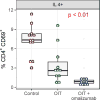Oral immunotherapy for food allergy
- PMID: 28865877
- PMCID: PMC5776738
- DOI: 10.1016/j.smim.2017.08.008
Oral immunotherapy for food allergy
Abstract
Food allergy is a pathological, potentially deadly cascade of immune responses to molecules or molecular fragments that are normally innocuous when encountered in foods, such as milk, egg, or peanut. As the incidence and prevalence of food allergy rise, the standard of care is poised to advance beyond food allergen avoidance coupled with injectable epinephrine treatment of allergen-induced systemic reactions. Recent studies provide evidence that oral immunotherapy may effectively redirect the atopic immune responses of food allergy patients as they ingest small but gradually increasing allergen doses over many months, eliciting safer immune responses to these antigens. Research into the molecular and cellular bases of pathological and therapeutic immune responses, and into the possibilities for their safe and effective modulation, is generating tremendous interest in basic and clinical immunology. We synthesize developments, innovations, and key challenges in our understanding of the immune mechanisms associated with atopy and oral immunotherapy for food allergy.
Keywords: Antigen-specific; Epitope; Oral food challenge; Sustained unresponsiveness; T helper 2 cell; Tolerogenic.
Copyright © 2017 Elsevier Ltd. All rights reserved.
Figures





References
-
- Gupta RS, Springston EE, Warrier MR, Smith B, Kumar R, Pongracic J, Holl JL. The prevalence, severity, and distribution of childhood food allergy in the United States. Pediatrics. 2011;128:e9–17. - PubMed
-
- Sicherer SH, Sampson HA. Food allergy: epidemiology, pathogenesis, diagnosis, and treatment. J. Allergy Clin. Immunol. 2014;133:291–307. - PubMed
-
- Jones SM, Burks AW, Dupont C. State of the art on food allergen immunotherapy: oral, sublingual, and epicutaneous. J. Allergy Clin. Immunol. 2014;133:318–323. - PubMed
Publication types
MeSH terms
Substances
Grants and funding
LinkOut - more resources
Full Text Sources
Other Literature Sources
Medical
Research Materials

